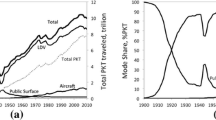Abstract
Transportation planners increasingly recognize telecommuting as an important trend. But while they often advocate telecommuting as a transportation demand management strategy, transportation planners have made little progress toward incorporating telecommuting into transportation forecasts, at least partly because of the limited data available. In this paper we explore four alternative methodologies for forecasting telecommuting and discuss the kinds of data that must be collected before these methodologies can be applied. The first approach is trend extrapolation, using curves of technological substitution. Sufficient data are currently available to produce forecasts, albeit highly uncertain forecasts, using this approach. However, even with better data this approach does not address underlying factors and trends that will affect the future of telecommuting. As a result, we explore three additional approaches that should produce more reliable forecasts but which require new data and knowledge about telecommuting: analyzing the characteristics of telecommuters in contrast to nontelecommuters, analyzing factors affecting the individual choice to telecommute, and incorporating telecommuting into traditional transportation forecasting models.
Similar content being viewed by others
References
Barff RA & Knight PL (1988) Dynamic shift-share analysis. Growth and Change 19: 1–10.
Behavior Research Center, Inc. (1990) Telecommuter Pilot Program Survey of Supervisors and Employee Participants. Prepared for AT&T, December.
Bernardino AT, Ben-Akiva M & Salomon I (1993) A stated preference approach to modeling the adoption of telecommuting. Transportation Research Record 1413: 22–30.
Blackman AW (1974) The market dynamics of technological substitutions. Technological Forecasting and Social Change 6(1): 41–63.
California, State of (1992) Telecommuting Pilot Project: Final Report. Review and Evaluation Branch, Department of Social Services, Sacramento, CA, April.
Caltrans (1992) State-of-California Annual Commute Survey. Data Provided by the Office of Traffic Improvement, Sacramento, CA.
Caltrans (1993) 1991 Statewide Travel Survey Final Report. Office of Traffic Improvement, Sacramento, CA, December.
Commuter Transportation Services, Inc. (CTS) (1992) State of the Commute. Los Angeles, CA.
Dickey JW (1983) Metropolitan Transportation Planning. Second Edition. Washington: Hemisphere Publishing Company.
Handy SL & Mokhtarian PL (1995a) Planning for telecommuting: measurement and policy issues. Journal of the American Planning Association 61(1): 99–111.
Handy SL & Mokhtarian PL (1995b) The future of telecommuting. Submitted to Futures.
JALA Associates, Inc. (1983) Telecommunications and Energy: The Energy Conservation Implications for California of Telecommunications Substitutes for Transportation. Final Report for the California Energy Commission, December.
JALA Associates, Inc. (1990) The California Telecommuting Pilot Project Final Report. Department of General Services, State of California, Sacramento, CA, June.
Mahmassani HS, Yen J-R, Herman R & Sullivan MA (1993) Employee attitudes and stated preferences towards telecommuting: an exploratory analysis. Transportation Research Record 1413: 31–44.
Meyer MD & Miller EJ (1984) Urban Transportation Planning: A Decision-Oriented Approach. New York: McGraw Hill Book Company.
Mokhtarian PL (1986) A Descriptive Analysis of Home-Based Workers in the SCAG Region in 1980, Draft. Unpublished report, Southern California Association of Governments, Los Angeles, CA, July.
Mokhtarian PL (1991) Telecommuting and travel: state of the practice, state of the art. Transportation 18: 319–342.
Mokhtarian PL, Handy SL & Salomon I (1995) Methodological issues in the estimation of the travel, energy, and air quality impacts of telecommuting. Transportation Research A, forthcoming.
Mokhtarian PL & Salomon I (1994a) Modeling the choice of telecommuting: setting the context. Environment and Planning A 26(5): 749–766.
Mokhtarian PL & Salomon I (1995) Modeling the choice of telecommuting 2: a case of the preferred impossible alternative. Environment and Planning A, forthcoming.
Mokhtarian PL, Salomon I, Saxena S, Sampath S, Cheung P, Le K & Bagley MN (1994) Adoption of telecommuting in two California State agencies. Submitted to Behaviour and Information Technology.
Mokhtarian PL, Brady T, Yates K, Lopez W & Bickel N (1988) Evaluation Report: Telecommuting Pilot Project for the Southern California Association of Governments. Southern California Association of Governments, Los Angeles, CA, August.
Nilles JM (1988) Traffic reduction by telecommuting: a status review and selected bibliography. Transportation Research-A 22A(4): 301–317.
Pisarski AE (1992) Travel Behavior Issues in the 90's. Prepared for the Office of Highway Information Management, Federal Highway Administration, Washington, DC, July.
Quaid M & Lagerberg B (1992) Puget Sound Telecommuting Demonstration: Executive Summary. Program Research, Washington State Energy Office, Olympia, WA, revised November.
RIDES for Bay Area Commuters, Inc. (1992) Commute Profile '92: An In-depth Look at Commuting in the Bay Area. San Francisco, CA, July.
Rosenthal NH (1990) Evaluating the 1990 Projections of Occupational Employment. Monthly Labor Review (August): 32–48.
Sullivan MA, Mahmassani HS & Yen J-R (1993) A choice model of employee participation in telecommuting under a cost-neutral scenario. Transportation Research Record 1413: 42–48.
US Department of Transportation (1993) Transportation Implications of Telecommuting. Washington, DC, April.
Wycech C & Cuddington J (1991) Bell Atlantic Telecommuting Pilot Final Report. December.
Author information
Authors and Affiliations
Rights and permissions
About this article
Cite this article
Handy, S.L., Mokhtarian, P.L. Forecasting telecommuting. Transportation 23, 163–190 (1996). https://doi.org/10.1007/BF00170034
Accepted:
Issue Date:
DOI: https://doi.org/10.1007/BF00170034




